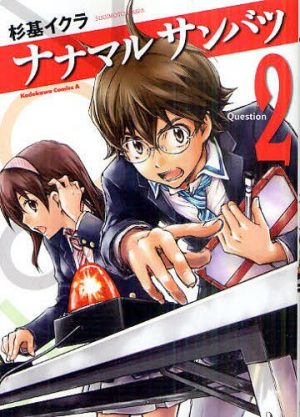Is it time to buzz in?
- Episodes : 12
- Genre : Seinen, Slice-of-Life, Sports
- Airing Date : July 2017 – September 2017
- Studios : TMS Entertainment
Contains Spoilers
Nana Maru San Batsu (Fastest Finger First) Introduction and Story (Spoilers)
Koshiyama Shiki was a lonely, bookish freshman at Buzou Academy whose only goal was to avoid his mother’s prodding to be more stylish. That all changes when he has a chance encounter with the school’s idol, Fukami Mari. Her cute looks and outgoing personality hide a deep passion for Quiz Bowl; a passion shared by Sasajima Gakuto, who has started his own quiz club. Koshiyama is skeptical at first, but ends up getting dragged to a meet with Fukami and another classmate named Inoue Daisuki (who largely only showed up due to a slight crush on Fukami).
At this meet, Koshiyama meets many of the various eccentric members of the Quiz Bowl community; most notably Mikuriya Chisato, an up and coming hotshot from Miura High School who’s a master at figuring out the question before anyone can buzz in. Koshiyama ends up entering the competition himself and even ends up making it past the first round, but is quickly knocked out in the second. As the tournament proceeds, Koshiyama accidentally answers a question out loud before any of the contestants can give their answer, which forces Sasajima to excuse Buzou’s club from the tournament.
From there, Koshiyama, Inoue, and Fukami practice quiz bowl in their club and learn more and more about each other’s motivations. Koshiyama is happy just to have friends and something to work towards, Inoue seems to enjoy the opportunity to hang out with Fukami, but Fukami seems to have a bit more going on in her life. We learn about how she actually has an older brother who was into quiz bowl, but stopped competing for unknown reasons. Fukami kept practicing, though, and is living in her brother’s shadow, hoping to one day to stand out on her own.
During this interval, and until the tournament at Asagaoka Girls’ High School, the Buzou team manages to acquire a new member: Sasajima’s younger sister Jinko. Jinko’s not really into Quiz Bow herself, but she’s quite the electrical engineer. She ends up building a personalized set of buzzers for each member of the club so they no longer have to resort to using a calculator as a makeshift buzzer during their practices.
Finally, it’s the day of the Asagaoka Girls’ Quiz Bowl meet, and all of the major players in the Quiz Bowl community are taking part! Sasajima reunites with his old friend Ohkura from Kaijou High School, the dominant school in the sport. Koshiyama, Fukami, and Inoue learn that Sasajima actually used to go to school with Ohkura and Fukami’s brother and that the trio was completely unstoppable. However, Sasajima decided to go on a separate path from his other two friends and resolved to start a club on his own for unknown reasons.
After the qualifying quiz, the girls of Asagaoka reveal the rules of the first round: a doubles round! Everyone gets paired up randomly, and the first 3 pairs to hit a certain score get to move onto the second round. Fukami manages to pass, but Inoue gets knocked out. Koshiyama, however, gets paired up with a deceptively aloof boy named Sonohara Akira who attends Sekigawata High School and also happens to be the younger brother of the Asagaoka Quiz Bowl club’s president, Sonohara Chiaki. Akira helps Koshiyama get by with some incredibly strange tactics, like setting their buzzers on top of each other so that they can simultaneously buzz in without delay from each other. These unique strategies don’t go over well with the other clubs, though, as they feel Akira is making light of the sport and needs to be taught a lesson by dismissing him from the tournament. In the end, they allow Akira to keep competing since there were technically no rules written to account for Akira’s strategies.
The series ends with the second round of the tournament, where Koshiyama goes up against his rival Mikuriya and his former partner Akira. As it turns out, Akira was actually a cross-dresser who helped out Koshiyama with some bullies at an arcade in a previous episode, but only joined his school’s quiz bowl team because he was disgusted with Koshiyama’s naïve love of the game and wanted to crush it. Eventually, watching Koshiyama and Mikuriya earnestly compete with one another and seeing how people are no longer reacting to what he’s doing, Akira drops out of the competition, but his club president at least talks Akira out of not dropping out of the club entirely. Koshiyama loses to Mikuriya in the end while Sasajima wins the entire Quiz Bowl on his own.
What We Liked about Nana Maru San Batsu
In an era of anime that tends to glamourize extremes, Nana Maru San Batsu is refreshingly realistic in its depiction of Quiz Bowl. No one has a “do or die” attitude towards the game where all of the character’s hopes and dreams rest on winning the big tournament and nothing else matters in their lives. Characters lose, but all it tends to elicit is an “Aw, shucks!” rather than it hurling them into a deep depression in which they re-evaluate how they play the game. There aren’t any grand arenas in which Koshiyama and Mikuriya duke it out on a neon lit stage. Nana Maru San Batsu has no delusions about the nature of Quiz; they’re a bunch of nerds who are renting out their school’s auditoriums (or in the case of Asagaoka, their school’s chapel) for the weekend and ask each other quiz questions.
It’s this more subdued take on the sports battle genre that gives the story an air of credibility. It’s a standard of the sports genre to glorify the joining of the club of a designated sport as this ideal place where a lonely teenager can find a social group and find a passion in their life. However, this message tends to get lost in over-exaggerated displays of emotion in order to draw the viewer into their story while forgetting the actual heart of their story. Nana Maru San Batsu’s story is fairly subdued, and actually feels like the sort of story you could have actually had in high school.
Discussion Time
For the most part, Nana Maru San Batsu’s biggest strength, outside of its more realistic depiction of the sport, comes from the diversity of rules in which Quiz Bowl can actually be played. While the series starts off with just the standard “multiple choice” style of question, the series wisely understands that it would quickly get repetitive if it solely focused on just who can buzz in faster when the question is read. Instead, we get a steady stream of new rules introduced over the series, culminating in the final matches at Asagaoka. A lot of the fun just comes from watching what new twist in the rules Nana Maru San Batsu will throw at you next.
However, it’s not a perfect series. While the first few episodes are for the most part fun, if pretty standard for the genre, and the tournament at Asagaoka becomes a suitable climax, the middle few episodes drag. It’s mainly done just to introduce new plot threads and characters, like the introduction of Akira and Fukami’s backstory, but it’s all fairly dry and uninteresting because of the lack of motivation for any of the characters. This is the weakness of the series’ more realistic atmosphere; because these are high school students whose only real goal is to have fun playing quiz bowl together, the stakes are extremely low. As a result, during these middle four episodes where we’re watching Koshiyama, Inoue, and Fukami get to know each other better and train for the upcoming tournament, there’s no real goal in mind. Yes, we like the characters and can relate to them, but at the same time, it’s difficult to invest yourself in their plights when you know they won’t lose anything if they fail.

1. Down-to-Earth atmosphere
This series does a lot to sell the view on its world beyond the reduced stakes. There are a lot of subtle details that do a lot to build up the Buzou High Gang. When Koshiyama and Inoue hang out at an arcade together, Koshiyama starts associating the quiz game they’re playing with Quiz Bowl, and he excitedly states how this will be a great educational experience for him. Inoue, rather than getting into his excitement, just has a moment of disappointment where he goes “Really?” where it’s clear he was just looking to have some fun with his friend on an off-day. It’s small moments like these that really build the series.
Also notable is Fukami’s unconventional voice direction. There was a lot of controversy (well, relatively) surrounding the decision to go with a huskier voice for Fukami as opposed to the traditionally cutesy voice most studios go with for their lady leads. We felt that this was actually a smart move for the directors considering the more natural setting for Nana Maru San Batsu. She actually sounds like a person rather than an anime character.
2. Everyone has a role

Sometimes in sports series, the main character ends up outshining everyone else on the team in terms of usefulness in the team or character growth. Yet, Koshiyama actually shares quite a bit of the spotlight with everyone else in Buzou’s Quiz Bowl club, most notably Fukami. Everyone’s got a history and their own niche within the quiz club. Fukami’s great at buzzing in during the classic questions, Koshiyama excels at literature and history, and even Inoue, who would have been easy to write as a walking punchline with his knowledge of otaku culture and obsession with girls, has a role as their pop culture and math expert. Sasajima manages to balance his almost goofy levels of stoicism for the sport with enough genuine love of the game that it’s hard not to root for him any time he’s on screen.
Even characters like Mikuriya and Akira manage to get some solid development. Akira with his cross-dressing would have been very easy to write as the butt of a lot of “gay panic” jokes, but honestly, the reveal of Akira’s gender is pretty subdued and no one seems to think that much of it barring an initial “Oh wow, huh, how about that” from everyone, with several of the girls commenting how cute Akira is. Akira even ends up getting a pretty genuine interaction with his club president about his future with the club. Mikuriya, meanwhile, plays the hot-headed alpha nerd rival, but this contrasts with his latent otaku tendencies (like making his player avatar a sexy woman when playing Koshiyama in an arcade game).
3. Keeps Quiz Bowl fresh
One of the difficulties of keeping a sports anime interesting is that the nature of the sport can sometimes get in the way. After all, you can only write “they grabbed the ball THIS WAY” or “they outran them using THIS TECHNIQUE” so many times before it starts to get repetitive or predictable. That’s why it’s nice that Nana Maru San Batsu manages to keep the sport interesting by constantly introducing new rules for the characters to play with. It keeps the viewer on their toes and keeps the series interesting just on a basic level to see what happens next.
1. Plodding pace
Ultimately, while the beginning works as a nice introduction to everyone, and the ending tournament is a mostly enjoyable romp, it does take a while in the middle to get to that point. Unfortunately, while the characters are fairly likeable, they also fail to inspire much passion in anyone watching the series. Their goals and stories are certainly relatable, but that doesn’t necessarily make them all that interesting. There’s no greater conflict at hand that a sports series like this would generally use to motivate its central characters to keep moving forward. Koshiyama doesn’t really have anything to lose from failing to beat Mikuriya beyond pride, and while maybe that’s the overall stake in other sports series, they sell it to you with such aplomb that you can’t help but be sucked into its drama. While it’s certainly possible to write a sports series with low-key emotional stakes, Nana Maru San Batsu fails at this, keeping it from achieving true greatness.
2. Koshiyama is an average hero
It’s extremely tricky to write a compelling, intentionally boring lead character. Nana Maru San Batsu attempts this with Koshiyama. However, between him, Fukami, Inoue, Sasajima, and Jinko, Koshiyama ends up as the weak link in the group. Fukami and Sasajima have surprisingly compelling backstories, and at least Inoue defies what you might expect from the second banana best friend of Koshiyama. But as for Koshiyama? His only real addition to the series is his bright-eyed earnest love of Quiz Bowl. It’s not exactly a unique take, and Nana Maru San Batsu does very little to give him much more of a character beyond that.
Final Thoughts
While it’s a small niche, there is certainly a fandom out there for realistic slice-of –life sports battle series. So if you’re looking for the next Baby Steps or Chihayafuru… well, Nana Maru San Batsu is certainly not at their level, but it is still a solid watch if you’re a fan of those kinds of shows.
Recommended Post
Nana Maru San Batsu - Summer 2017 Anime
Recommended Post
[Honey's Crush Wednesday] – 5 Gakuto Sasajima Highlights - Nana Maru San Batsu (Faster Finger First)
Recommended Post



